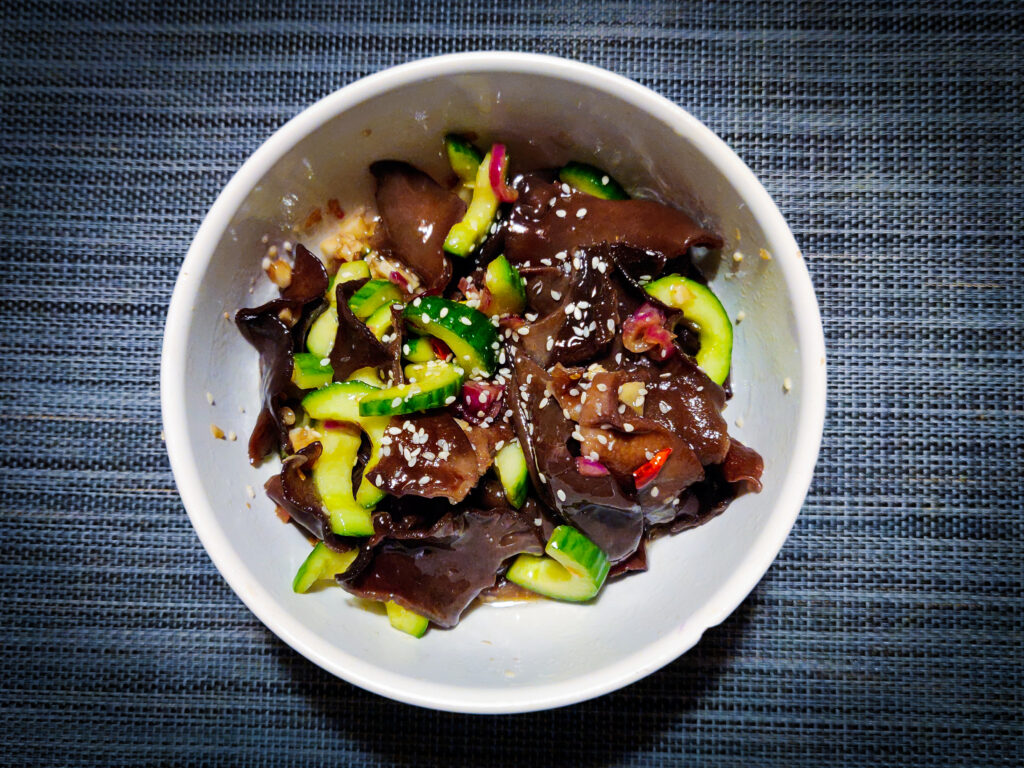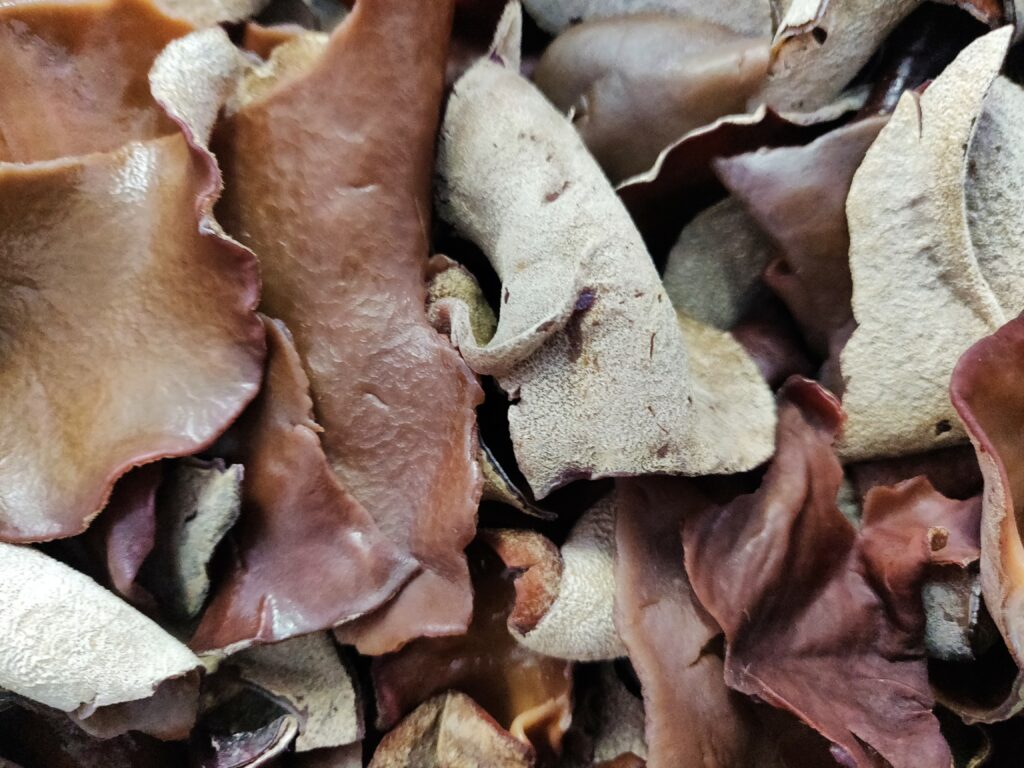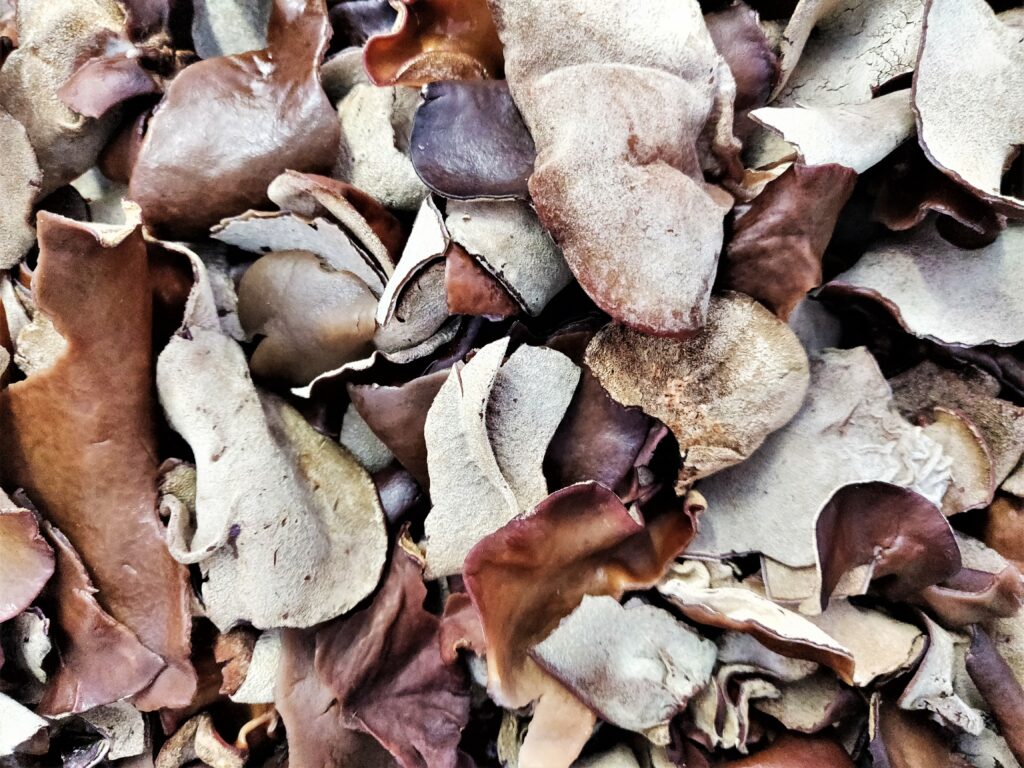The ‘wood ear‘ is the name translated directly from Chinese ‘Mu’er 木耳‘ for a group of related edible fungus. Most commonly, this refers to the ‘black wood ear‘ – the Auricularia auricula-judae – which comes from its common English name, “Judas’ ear“.

History of the Wood Ear in Europe and in China
The black wood ear has been known in Europe for centuries, although it had never been considered an edible fungal ingredient like in China. The name ‘Auricularia auricula-judae‘ refers to the belief that Jesus’ betrayer and disciple Judas Iscariot hanged himself from an elder tree and the fungus that sprouted was a remnant of his body.
Nevertheless, Judas’ Ear had been used in medieval folk medicine for the treatment of ailments such as sore throat, eye infections and even jaundice.
In China however, the black wood ear was and still is highly valued for both its culinary and medicinal uses. It is added to soups and salads, and used as an effective ‘coolant against heat in the body’. The cultivation of black wood ear dates back to as early as the 7th century.
How is eating Wood Ear good for you?
Recent studies using mice show that black wood ear show potent antitumour properties. It also has hypoglycemic effects that help lower blood sugar levels. The best news of all, is that the Auricularia auricula-judae can effectively lower cholesterol levels in general, and in particular those of bad cholesterol.

Differences between Fresh and Dried Wood Ear
Do not eat fresh, uncooked wood ear! I found these lovely fresh wood ear from my local supplier. Thinking that fresh is better than dried, I looked up the differences between the two. To my horror, the consumption of fresh UNCOOKED wood ear is highly discouraged! It contains porphyrin that causes solar dermatitis, which leads to rashes and skin irritation when you are exposed to the sun.
However, by cooking the fresh wood ear instead of just directly eating it, you will lower the levels of porphyrin in the fungus. However, by drying the black wood ear in the sun, the porphyrin levels will be completely eradicated. Thus in this case, consuming dried wood ear is far better than consuming the fresh one!
Fresh black wood ears are very soft and fragile. They are brown with a white undercoat. Dried black wood ears look the same although all shriveled up. But after re-hydration, the dried ones become more springy and bouncy which will be even more pronounced when cooked.
So if you really really prefer the fresh ones to the dried ones, make sure you cook them very thoroughly, and consume them when they mostly fruit – in the autumn – and when you run less risk of sun exposure.
Below is a quick and easy Chinese recipe for a wood ear salad known as “Liangban Mu’er” 凉拌木耳. It is a very common side dish in China and every family has their own version. Mine includes mini cucumber whose crunch complements the soft chewiness of the black wood ear.
Ingredients:
- 50g dried wood ear or 100g fresh wood ear
- 1 mini cucumber, seeded and sliced
- 5 stalks coriander, roughly chopped
- 2 shallots, finely sliced
- 2 cloves garlic, minced
- 4-5 dried/fresh bird’s eye chilies (optional)
- 1 tbs light soy sauce
- 1 tbs aged Chinese vinegar
- 1 tbs sesame oil
- 1 tbs Sichuan pepper oil
- 1 pinch chicken stock powder (optional)
- 1 tbs oyster sauce (optional)
- 1 tbs red chili oil (optional)
- 1 tbs sugar
- 1 tsp salt
- 1 pinch roasted white sesame seeds
Serving: As a side dish.
Instructions:
- Wash and soak your dried black wood ears in a bowl of water for 1 hour. They will puff up to twice their size. Add 1 tablespoon of plain flour to the water and scrub the wood ears rigorously to get rid of impurities. Rinse with fresh water. If you are using fresh wood ears, skip this step.
- Bring to boil a pot of water. Meanwhile, tear with your hands or cut with a knife the wood ears to manageable bite sizes. Cook the wood ears in the boiling water for about 5 minutes. Strain and leave aside to cool down.
- Place your sliced mini cucumber, chopped coriander and sliced shallot in a mixing bowl.
- In another bowl, mix all other ingredients to make the sauce.
- Mix your cooled cooked black wood ears and the existing ingredients in the mixing bowl with chopsticks or using a disposable glove. Mix in the sauce thoroughly.
- Serve on a plate as a side dish.
Tip: Add or reduce the ingredients according to your personal taste. Sometimes I prefer more cucumber and garlic, and other times I actually added more chilies to turn up the heat.



1 Comment